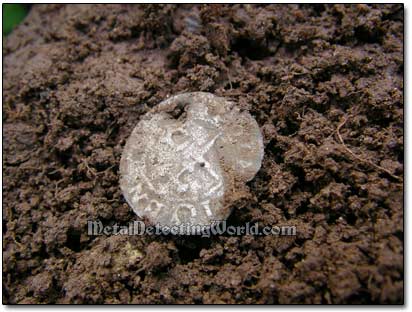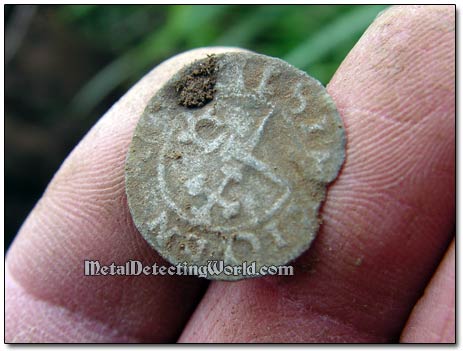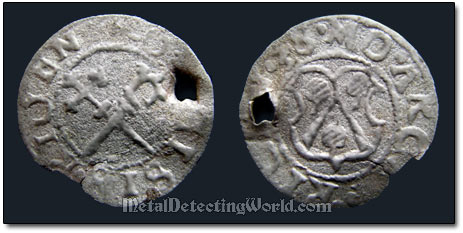Part I - Metal Detecting at the Swedish Tavern Site, page 11
Recovering 1538 Schilling of Archbishop Thomas Schöning of Riga
With that thought, I began searching the last undetected strip of land in my lot. I received a signal, dug the dirt plug out, spotted a small coin's edge of white metal in it and realized that I had just hit the boundary of the "hot" spot!
It was not a signal that I had desired to hear - a loud coin signal of high-pitch tone. It was rather a weak signal of a low-pitch tone. When I saw a silver hammered coin in the dirt plug, I knew we were at the right spot. I shouted, "Silver!" (both in English and Russian) - to my buddies, and they ran to me to look at my amazing find.

This was a very thin coin of 17mm in diameter, and usually such coins would have a low silver content of below 0.250. The coin's thinness and low silver content were two good reasons explaining why the coin gave out a signal of low conductivity. Coins of this type are seldom found in this part of Russia, though it should be the opposite if to consider the history of the region. In fact, I had never seen any report of such coin's discovery in this area. So this was my rare coin-find confirming that we were at the edge of a "virgin" site!

Because of the coin's round shape and legend, we knew right away that it was not a Russian hammered coin of the tsar Ivan The Terrible, which is a characteristic coin-find for this area. The coin design suggested that the coin was minted either in neighboring Estonia, which was Swedish Estonia back then, or Latvia (part of Swedish Livonia in the 16-17th centuries).
Only later, after conducting a substantial research, I could correctly identify this coin. This was 1 Schilling (Solidus) minted under the order of Archbishop Thomas Schöning of Riga (now the capital of Latvia) in... 1538! This coin was much older than the metal detecting site itself. Presence of the 16th century coin at this 17th century location could be explained by the fact that the silver coin was holed - it was worn on a string around the neck as a good luck charm for many years before it ended up here.
The coin's obverse depicts the family coat of arms of Thomas Schöning - two rafters at angle to each other with three lime-trees.

The reverse shows the coat of arms of Archbishopric of Riga: a cross and a scepter crossing each other.

1538 Schilling of Archbishop Thomas Schöning of Riga

OBVERSE: Family coat of arms of Thomas Schöning in shield, legend around: .MO.ARCH.P.RIGEN.1538
REVERSE: Archbishopric coat of arms, legend around: +MO ECLESIE:RIGEN
COIN DIAMETER: 17mm
COIN WEIGHT: 0.80g
SILVER CONTENT: Ag 187.5/1000 (.1875)
MINT: Koknese
Silver Schilling (Solidus) replaced Artig (Swedish: Ortug) during the monetary reform of Livonia Confederation in 1422-1426. Since the middle of 15th century, schillings were struck in the Archbishopric of Riga, the Order of Livonia, the Free City of Riga (1561-1581), and during the reigns of Poland (1581-1621) and Sweden (1621-1665); 1 Schilling = 1/96 Daler or 1/24 Mark or 1/3 Öre.
The Archbishopric of Riga - Brief Historical Facts:
The Archbishops of Riga (1186-1561) were the secular rulers of Riga, the capital of Terra Mariana (now Latvia) in medieval Livonia. Archbishops had a right to mint their own coins, the profits from coin minting were divided three ways between the Archbishopric of Riga, City of Riga (without the right to place its coat of arms on coins) and Livonian Order.
Archbishop Thomas Schöning ruled from 1528 to 1539 and was the first who began placing the dates on coins of the Archbishopric of Riga. Thomas Schöning moved his residency to Koknese (Kokenhausen) in 1528, because of the conflict with both Riga City and the Livonian Order, where he minted the coins bearing his family’s coat of arms. The Archbishopric of Riga was abolished in 1561 due to the conversion of the Livonian Order's territory from Catholicism to Lutheranism at the beginning of the Swedish rule which was the longest in Livonia: from 1561 to 1710.